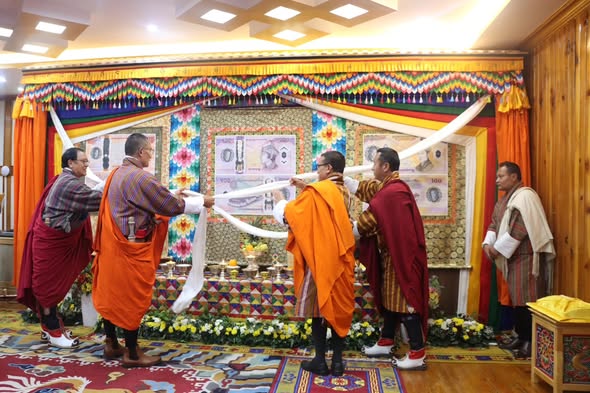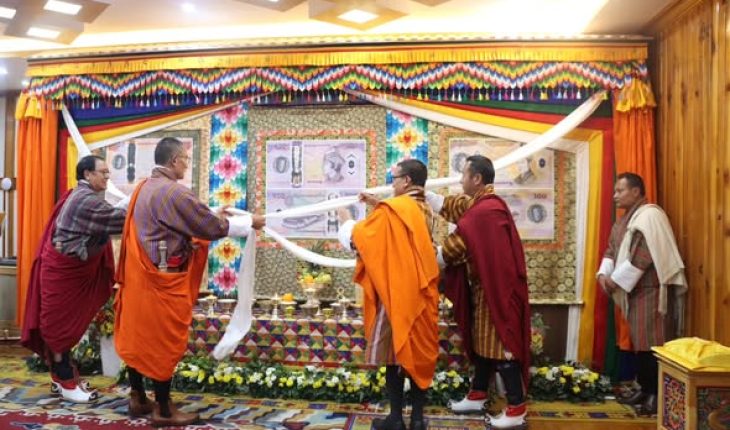
The notes will enter circulation beginning in January 2026
RENUKA RAI | Thimphu
Bhutan has entered a defining moment in its modern history with the unveiling of a new generation of Ngultrum banknotes that bring together the nation’s royal legacy, spiritual identity, and enduring commitment to environmental stewardship.
Announced by the Royal Monetary Authority of Bhutan (RMA), the redesigned notes pay tribute to the 70th Birth Anniversary of His Majesty the Fourth Druk Gyalpo, Jigme Singye Wangchuck, while also celebrating the lineage of monarchs who shaped the country from its unification to the present era.
More than just a redesigned currency, the new Ngultrum series is being embraced as a national tribute that captures Bhutan’s values, its evolution, and its reverence for its kings.
The banknotes—Nu. 1000, Nu. 500, and Nu. 100—will enter circulation beginning in January 2026. Importantly, existing notes will remain legal tender, allowing a smooth transition as the new series gradually makes its way into daily use.
The most striking feature of the new notes is their material. Unlike previous paper-based designs, the new Ngultrum series is printed entirely on a polymer substrate. This shift marks a major modernisation step for Bhutan’s currency management. Polymer notes are longer-lasting, cleaner, more resistant to wear, and easier to recycle.
Many countries have adopted polymer for its durability and environmental advantages, and Bhutan’s transition signals not only technological progress but also a reaffirmation of its commitment to sustainability. In a nation where environmental conservation is rooted in policy, culture, and identity, using polymer reflects both practicality and principle.
Yet the innovation in material is only one part of the transformation. What stands out most is the depth of symbolism woven into the banknotes’ design.
Rather than being solely tools for transactions, the new notes operate as visual narratives—each denomination telling a chapter of Bhutan’s history, monarchy, and national journey. Every element, from the crowns to the fortresses to the mythical creatures, carries meaning that binds Bhutan’s past to its future.
The timing and purpose of the new Ngultrum series underscore the deep emotional resonance it carries throughout the country. His Majesty the Fourth Druk Gyalpo is remembered as one of Bhutan’s most transformative leaders.
His visionary approaches to environmental protection, socio-economic planning, governance, and international relations shaped what we now recognise as modern Bhutan.
His majesty also introduced the philosophy of Gross National Happiness, established strong conservation policies, expanded social services, strengthened cultural preservation, and guided Bhutan through the transition to a democratic constitutional monarchy.
Releasing a new series of banknotes on the occasion of his 70th Birth Anniversary thus becomes a national gesture of gratitude. Each note, while dedicated to a specific king, is anchored by shared symbols of unity and continuity—representing how the monarchy, across generations, has provided guidance, protection, and direction to Bhutan.
The highest denomination in the series, the Nu 1000 note, transports the public back to 1907, the year Bhutan unified under its first king, His Majesty Ugyen Wangchuck. Widely respected as a skilled diplomat and a unifying leader, his reign marked Bhutan’s emergence as a stable, consolidated nation-state.
On the front of the note, His Majesty is depicted wearing the Raven Crown—the sacred royal crown bestowed upon him by his father, Desi Jigme Namgyel. The Raven Crown is among the most iconic symbols in Bhutanese history, signifying protection, wisdom, and the sacred responsibility of rulership. Behind him, the Wheel of the Universal Ruler underscores the moral authority and rightful leadership embodied in the founding of the monarchy.
The reverse side of the Nu 1000 note features Trongsa Dzong, one of Bhutan’s most historically significant structures. As the ancestral seat of the Wangchuck Dynasty, Tongsa Dzong has long been associated with leadership: traditionally, the Crown Prince served as the Trongsa Penlop before ascending the throne. The Dzong’s image thus anchors the note in themes of continuity, stability, and national unity.
Surrounding the Dzong are the State Seal and two hornbills, birds known for their elegance and symbolic significance in Bhutanese ecology. The hornbills highlight Bhutan’s deep connection with its forests and conservation efforts, reminding the public that the monarchy’s legacy is intertwined with nature. Mythical protectors—the dragon and the Garuda—hover above the Dzong, representing vigilance, spiritual protection, and the safeguarding of Bhutan’s sovereignty.
The Nu 1000 note is therefore not just a high-value denomination; it serves as a tribute to the founding father of modern Bhutan and the early leadership that shaped the nation.
The Nu 500 note is dedicated to His Majesty Jigme Singye Wangchuck, the Fourth Druk Gyalpo, whose vision and compassion transformed Bhutan’s trajectory in the late 20th and early 21st centuries.
His Majesty’s portrait on the front is set against a backdrop of the cross-vajra, representing stability, protection, and spiritual strength—values that defined his reign. His leadership was marked by profound reforms: the creation of Gross National Happiness as a guiding philosophy; the establishment of the Royal Monetary Authority and the Bank of Bhutan; and policies that ensured at least 60 per cent of Bhutan’s land would remain under forest cover.
On the back of the Nu 500 note stands Punakha Dzong, one of the most sacred and historically important sites in Bhutan. As the final resting place of Zhabdrung Ngawang Namgyal, the founder of Bhutan, the Dzong is a symbol of both spiritual authority and national identity. It has hosted countless royal ceremonies, including the coronations of kings.
Rising above Punakha Dzong is the Khamsum Yulley Namgyal Chorten, a modern architectural masterpiece built to bring peace and harmony to all sentient beings. Its presence in the design symbolizes protection, blessings, and continuity of spiritual guidance.
Intricately placed on the note are Bhutan Glory butterflies, a rare species found in the country. Their inclusion is a tribute to the Fourth King’s environmental legacy—a legacy that helped Bhutan become globally recognized as a carbon-negative nation.
The Nu 500 note ultimately reflects an era of transformation, modernisation, and profound care for Bhutan’s people and environment.
The Nu 100 note highlights the leadership of His Majesty King Jigme Khesar Namgyel Wangchuck, the Fifth Druk Gyalpo, revered for his compassionate, people-centered approach to leadership. His reign has been marked by national unity, strong youth empowerment initiatives, digital and economic modernisation, and an unwavering focus on enhancing the welfare of citizens.
The front shows His Majesty wearing the Raven Crown, surrounded by a detailed cosmic mandala. The mandala symbolizes harmony, balance, and the interconnectedness of the nation. Encircling it are sensory offerings and nine dragons, representing prosperity, blessings, and spiritual strength. These elements mirror the holistic guidance His Majesty provides as Bhutan navigates contemporary challenges.
The reverse features Tashichho Dzong, the seat of the Royal Government, which stands as a symbol of governance rooted in Buddhist values and national identity. Above the Dzong soars the Garuda, a protector figure in Bhutanese mythology. The State Seal appears alongside, reinforcing themes of national unity and administrative strength.
The Nu 100 note frames Bhutan’s present era—one defined by resilience, modernisation, and a deepening of the country’s commitment to national wellbeing.
While each denomination has its own narrative, the series is bound together through shared symbols that emphasise unity and continuity. A striking feature is the shimmering foil stripe showing a dragon clutching jewels in its claws. The dragon—Druk—reflects Bhutan’s identity as the Land of the Thunder Dragon. The jewels represent prosperity and the fulfillment of aspirations.
All notes also carry watermarks of His Majesty the Fifth Druk Gyalpo and the cross-vajra, signifying stability, legitimacy, and the unbroken line of wisdom and leadership from one monarch to the next.
These shared visual threads tie the notes together as a single story—one of monarchy, spirituality, protection, and national values.
Across Bhutan, the introduction of the new generation Ngultrum notes is being welcomed with a mix of pride, reflection, and heartfelt emotion. For many, the notes serve as daily reminders of the legacies of three kings who shaped the nation’s path.
They also bring history into the hands of ordinary citizens, allowing people to reconnect with Bhutan’s journey each time they make a purchase, offer butter lamps, pay for bus fares, or exchange money in the market.
The initiative also highlights Bhutan’s ability to balance tradition with innovation. While the designs honour centuries-old symbols and stories, the use of polymer represents a step toward financial modernisation and environmental resilience.
As Bhutan moves forward, these new notes will circulate not just through wallets and shops, but through the collective memory of the nation. They will carry stories of unity, leadership, and gratitude—ensuring that the legacy of Bhutan’s kings, and the spiritual depth of its identity, remain alive in everyday life.





